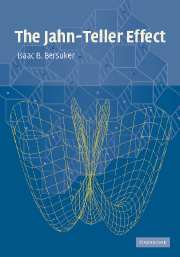Book contents
- Frontmatter
- Contents
- Preface
- Abbreviations
- 1 Introduction
- 2 Vibronic interactions
- 3 Formulation of Jahn–Teller problems. Adiabatic potentials
- 4 Pseudo Jahn–Teller, product Jahn–Teller, and Renner–Teller effects
- 5 Solutions of vibronic equations. Energy spectra and JT dynamics
- 6 The JTE in spectroscopy: general theory
- 7 Geometry, spectra, and reactivity of molecular systems
- 8 Solid-state problems: local properties and cooperative phenomena
- Appendix
- Subject index
- Formula index
8 - Solid-state problems: local properties and cooperative phenomena
Published online by Cambridge University Press: 07 December 2009
- Frontmatter
- Contents
- Preface
- Abbreviations
- 1 Introduction
- 2 Vibronic interactions
- 3 Formulation of Jahn–Teller problems. Adiabatic potentials
- 4 Pseudo Jahn–Teller, product Jahn–Teller, and Renner–Teller effects
- 5 Solutions of vibronic equations. Energy spectra and JT dynamics
- 6 The JTE in spectroscopy: general theory
- 7 Geometry, spectra, and reactivity of molecular systems
- 8 Solid-state problems: local properties and cooperative phenomena
- Appendix
- Subject index
- Formula index
Summary
The JTE in local properties of solids
Local properties in crystals are strongly affected by JT vibronic coupling phenomena, quite similar to molecular systems discussed in the previous chapter. There is no sharp border between clusters and coordination systems, considered in Sections 7.6.1 and 7.6.2, and local formations in crystals (which are often modeled by clusters). Differences occur for impurity centers for which the JT problem is in fact a multimode one (Sections 3.5 and 5.5) with a very large (infinite) number of JT active modes that are significantly involved in the vibronic coupling. Another important crystal problem emerges when there are multiple JT impurity centers at sufficiently small intercenter distances with sufficiently strong interaction between them. In the limit of an infinite number of such JT centers that occupy regular positions in the lattice we come to the cooperative JTE (CJTE) considered in Sections 8.2 and 8.3. The JTE in superconductivity and colossal magnetoresistance is discussed in Section 8.4.
Impurity centers in crystals
We start with a single JT center in a regular crystal in the form of an impurity center or a lattice defect that has localized electronic states. The latter may be either orbitally degenerate and subject to the JTE (when the crystal field of the environment has at least one axis of symmetry of third or higher order), or pseudodegenerate with a PJTE (for which there are no symmetry restrictions, but the ground state should be force-equilibrated in the reference configuration, Section 4.1).
- Type
- Chapter
- Information
- The Jahn-Teller Effect , pp. 479 - 597Publisher: Cambridge University PressPrint publication year: 2006



